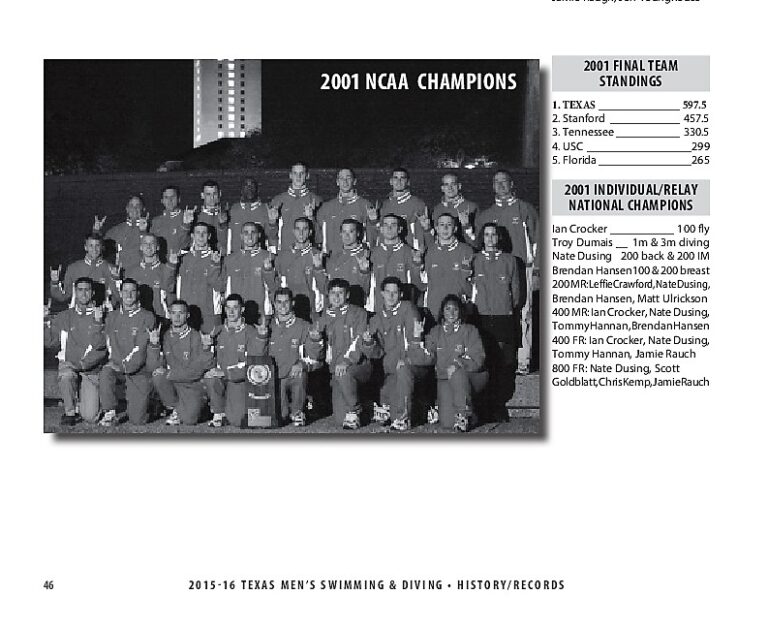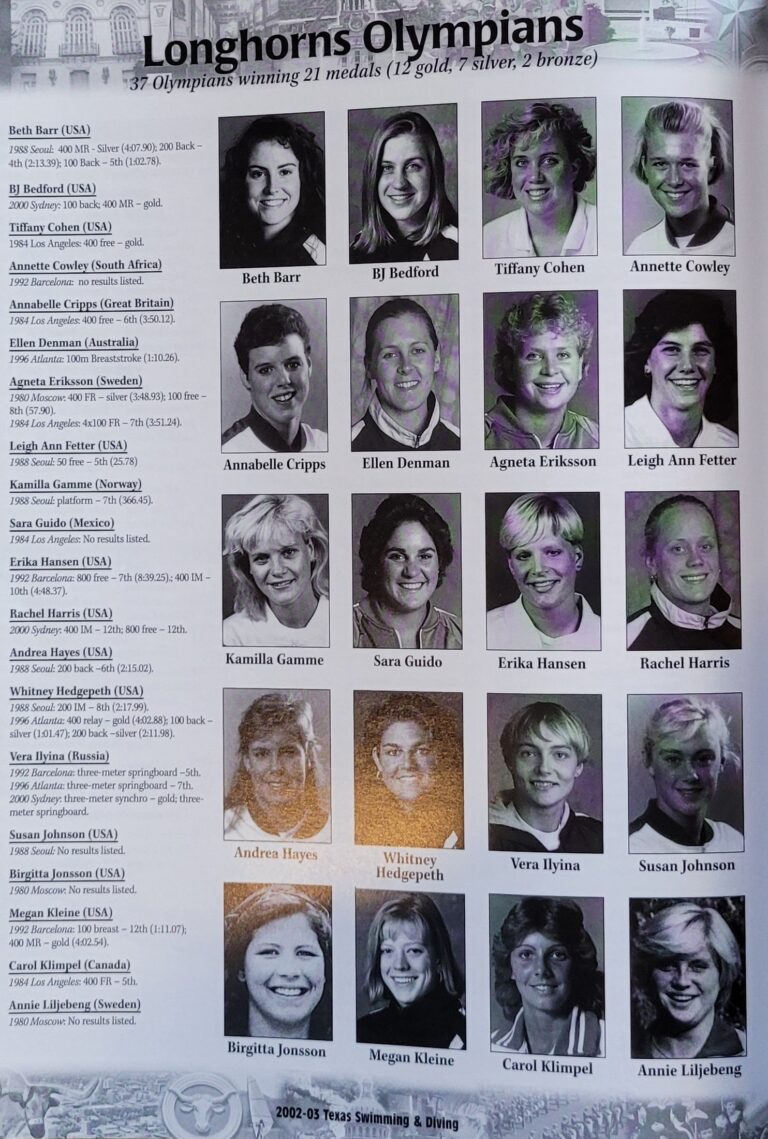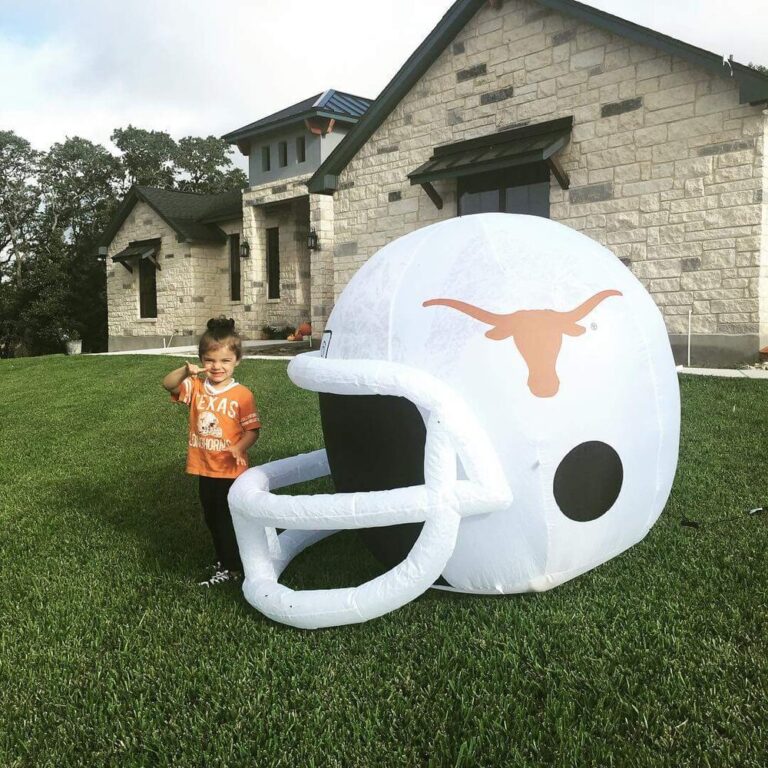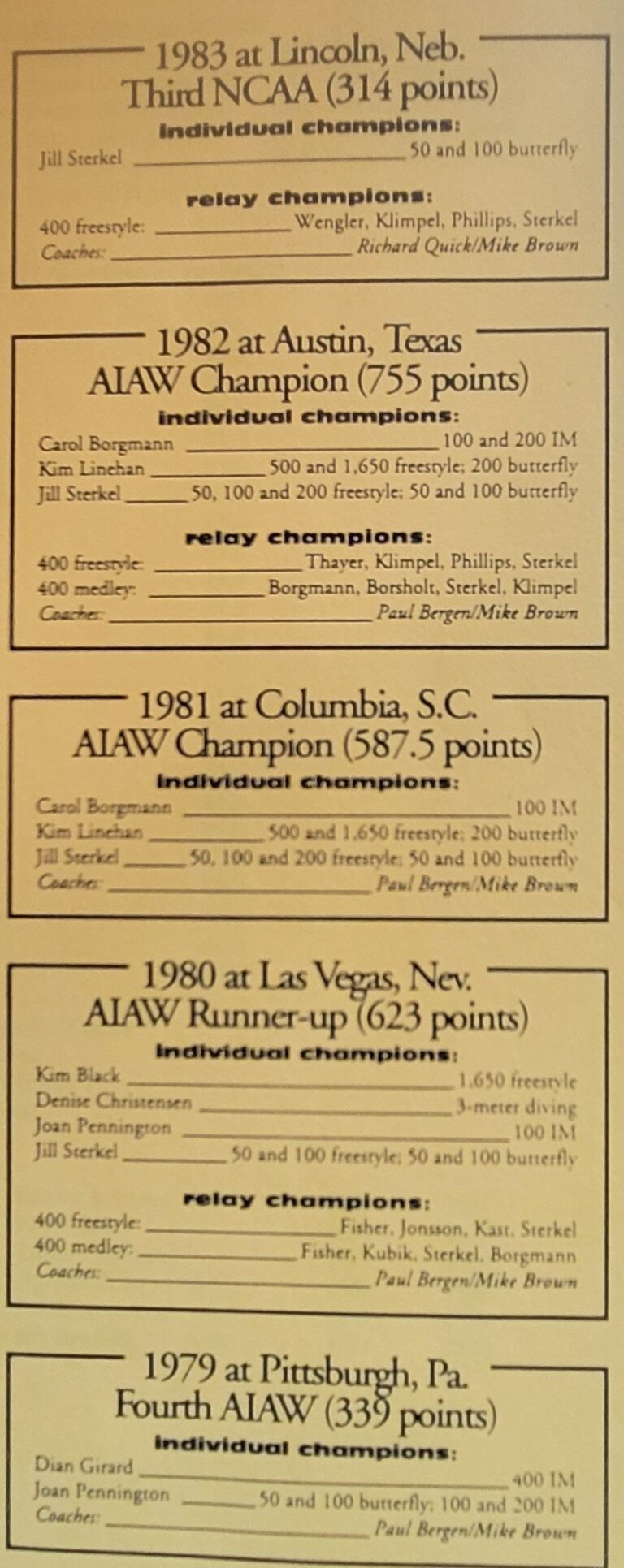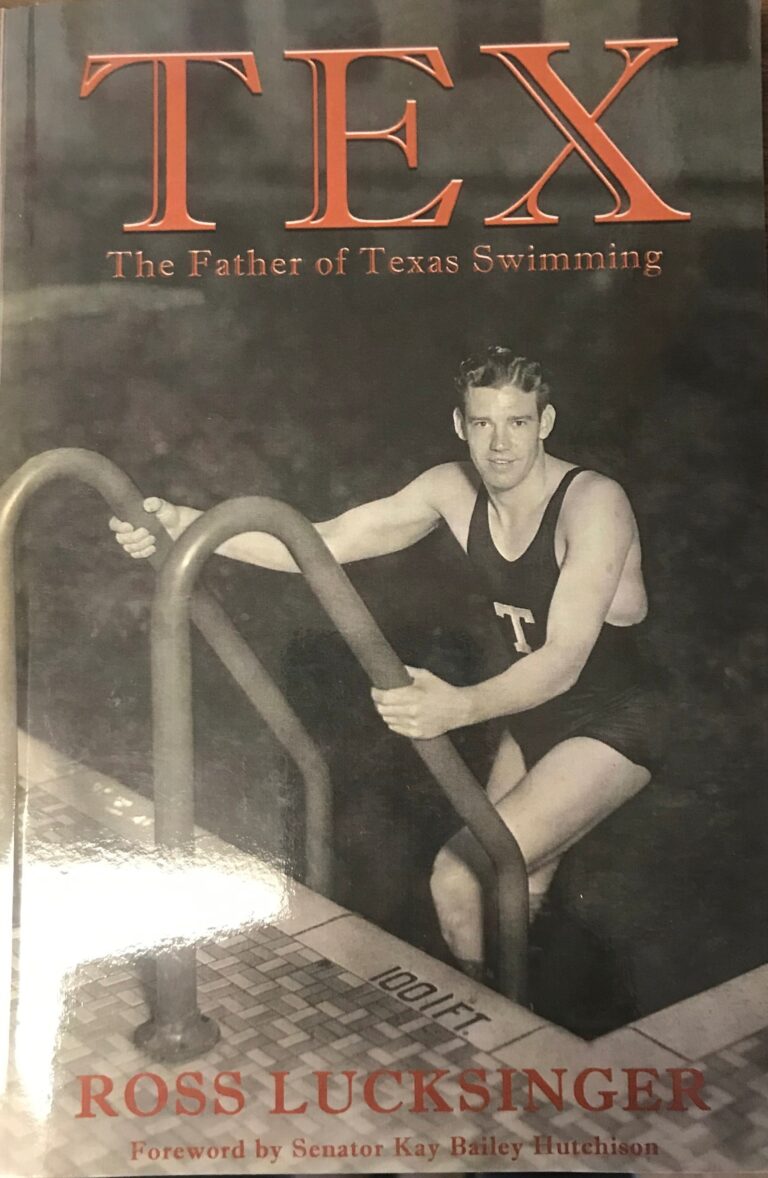1934-1950 Coach Tex Robertson- swimming
COACH TEX ROBERTSON – 1935-1950
Coach Robertson learned to swim in Sweetwater, Tx.
-
Tex Is an alternate in the 1932 Olympics
-
Coach’s 72 SWC swimming champions, 17 All Americans, 4 Olympians
-
Develops Camp Longhorn- one of the nations best summer camp programs.
-
He is best known for inventing the flip turn.
-
1950 is NCAA Coach of the year.
-
Creates TAGS (Texas Age Group swimming)
1935- Coach “Tex” Robertson
According to the book TEX- The Father of Texas Swimming by Ross LuckSinger, Ed Barlow, the physical education professor, convinced AD Chevigny to hire Tex as the swim coach by telling Jack Chevigny “Jack he is already down there coaching anyway.” Coach Robertson starts on his adventure with no budget, no scholarships, and no salary while football coach Bible is hired for $15,000 a year. Tex Robertson the promoter uses recruiting and marketing skills to build the Horns into a swimming powerhouse. Tex by sheer moves swimming from a minor sport to a major sport at Texas. He uses his own money to buy equipment. Even though Tex had no scholarships to offer he promised scholarships to some of the key swimmers across the country; “swimmers he asked to commit … to a program he wasn’t yet coaching .” “His solution was to pay for as much of his swimmers’ scholarships as he could with his own money. Admirable but clearly not allowed under NCAA rules. Coach Reese the present Coach of the Longhorns said Tex help was “morally fine. Ethically fine. NCAA’-LY , he was a dead man.
“Tex played by his own rules, but he knew how to win and his swimmers loved him for it.” Including breaking a Federal Law. After the war military men part of the ROTC could hop on flights at any time . In 1950 two of Tex Robertson All Americans – Gilbert and Crawford- missed their flight to the NCAA championship. Gilbert was ROTC and could use his military status to make the Championship tournament, but Crawford was only a civilian with no priority boarding rights. Tex took care of that problem. Tex borrowed one of Crawford’s fraternity brothers uniforms and ID, and Crawford and Gilbert made it to the NCAA championship in time to participate. However, If Crawford had been caught , he could have been prosecuted for impersonating an officer.
.
1936
1936-Coach “Tex” Robertson The “Pre-Olympic swimming carnival- SWC champions
Johnny Crawford received the first legitimate Longhorn swimming scholarship.
The main event was the beauty contest voted on by the swimmers. The Aqua -belles were initially dressed in sport clothes instead of swim suits because of the mores of the day. It was not until 1940 that the beauties started to wear swimming suits. Eddie Gilbert says that ““They (fans) wouldn’t come to see us swimmers. They’d come to see the girls.” Kathryn Grant was one of the queens and she married Bing Crosby years later. Tom Landry of the Dallas Cowboys won the 1947 “Most handsome man Aqua festival award.
Swim team makes its first out of state swim meet and beats Washington and Kansas State but loses to Nebraska.
A University of Texas All-American, Wally Hoffrichter is a member of the 1936 U.S. Olympic Water Polo Team and the first president of the Texas Interscholastic Swimming Coaches Association and TAGS.
The 1936-1937 season was a defining moment in Coach Robertson’s career in Texas. In his first year, the Longhorns were listed in the top 40 nationally; the next year, they were in the top 20, and in 1936-1937, they were in the top 5. At the SWC meet, the team set five conference records.
Thurman Talley is an All-American (no pictures)
1937-Coach Robertson’s team scored 4 points at nationals
The Fascinating Story of Hondo Crouch
Hondo was known as the “Swimming Cowboy” because he dressed like a B-movie cowboy, played a guitar, and wore boots and a cowboy hat with his swimsuit at swim meets. His colorful character brought recognition to his community, the Hill Country, and his state simply because he was an original. Texas Monthly dubs him “The Most Professional Texan.”
He and his teammates are pioneers in the young life of Texas swimming, and for a quarter of a century, Hondo coached, promoted, and directed swimming for hundreds of kids. In 1970, as owner and mayor of Luckenbach, Texas, he is tagged as a folk hero. “The Clown Prince” and “Imagineer, Authorized Distributor” were some of his titles. Upon seeing the unfinished new Texas Swim Center, he remarks, “Gollee! Just think of all the bales of hay I could store in here!” His grandsons Ren and Kit Patterson followed his tradition and swam at Texas under Coach Eddie Reese. Author James A. Michener wrote, “Hondo said he was a legend in his own mind. He is definitely a Texas legend in my mind and in the minds of countless others.” For more on Hondo, visit the search engine and search for “Hondo” .
Hondo’s induction into the TSDHOF is
http://www.tsdhof.org/hondo-crouch
Bob Tariton, Mike Sojka, and Hondo Crouch are All Americans
Photo from Hondos scrapbook. In New York, Swim meet at Rutgers, Flanagan on left.
Austin news article-UT swim coach Tex Robertson obtained world-famous Adolf Kiefer, Olympic champ and holder of two backstroke titles; Ralph Flanagan, “Alligator Boy” from Miami, world record holder in 5 events; Mike Sojka from Buffalo, the “Flying Fish” breaststroke champ; Wally
Adolph Kiefer is the first Longhorn to win an Olympic gold medal. He did so in world record time.
Topping the Charts in 1937
This team was the first Longhorn team to score points at a national event. (4) points
The swim team put on a three-day aquatic show at Gregory Gym. There was great entertainment, with trapeze stunts, double dives by the Chapmans, and record-setting swimmers Flanagan, Kiefer, Sojka, and the famous Jane Dillard showing off their skills.
This team set swimming records in the 200-meter relay, the mile relay, the 150-meter freestyle, and the 100-meter freestyle. Texas won the SWC by winning first in all 10 events.
1938-Coach Robertson team
Coach Robertson and six swimmers purchased a Lincoln to travel around Austin and take road trips. The car was painted orange with a “T” on the side and Horns on the front grill.
Final exams and other unfortunate occurrences reduced the squad by 4 team members. While these losses eliminated any chance of winning the national championship, the Longhorns still won the SWC and beat Washington, Kansas, and Kansas State in intersectional rivalries.
Rollin Baker was the Captain. Coach Robertson did not except pay for his job so he could maintain his amateur Olympic standing.
1939 Coach Robertson Pending more information
The winner of the 1939 team’s 400-meter relay was Donnall Thomas, who in 1990 won the Nobel Peace Prize. He was known as the “Father of bone marrow transplantation.”
The swim team adopts 1939 Longhorn logo. Horns are level with the Longhorn head.
Billy Brink and Adolph Kiefer are All Americans (no photos)
1940 Coach “Tex” Robertson Pending
The Aquacade continues to dazzle the fans. Jane Dillard broke several records and the divers – Hank Chapman, Billy Brink, and Bab Papich awed the fans with daring dives from the board and tower.
By 1940 some of Tex 1937 recruits had left the Longhorns . Flanagan left to pursue professional swimming. Kiefer left to be in the movies under contract with Paramount Pictures.
Hank Chapman is an All-American
1941 Coach “Tex” Robertson Pending
1940-1941 swimming front- Choniske, McClamroch, Papich, Kidd – second Charles Taylor, Denton, Smith, Beeler-third- James Randall, Harry Williams, Tex Robertson, Tarlton, Newman
The 6th Annual Aquacade was a huge success, with Mike Sojka and Jane Dillard setting some American records. The team wins 10 SWC championships.
1942 Coach “Tex” Robertson Pending
Due to heavy losses to military service, the Aggies were the first team to beat the Longhorns to win the SWC championship. However, the Aggies still lost to the Horns in the SWC tournament, and Texas won its 11th conference championship.
1943 Coach “Tex” Robertson SWC Champs
Despite having part of his hand shot off on Iwo Jima, Bill Johnson still wins the 50 free in the SWC meet.
Bill Johnson is a huge part of Texas Swimming history. He was captain before and after WWII. He earned a Purple Heart for his bravery at Iwo Jima, invented the Blob while director at Camp Longhorn and was a community legend.
1944 Coach Art Burnham Co-SWC Champions
For the first time since swimming was instituted as a SWC the Longhorns did not win the SWC championship outright. Tex was on leave and in the Navy and Chief Art Burnham a physical training instructor for the Navy was the coach. Captain Ed Seidel was the best swimmer at the meet.
Front row- Focht, Singletary – second row. Upham, Helms, Seidel, Pearce, Bollinger, Crossen, back row- Burnham, White, Buckles, Green, Mellenthin, Packard, and Cook
1945 Coach Bob Bollinger fills in for Robertson while he is on duty with the Navy
Front- Seiling, Schoeller, Hill, Linn
2nd row- Bollinger, Bean, Upham, Pierce, Carpenter, McLellan, Mitchell,
back row- Grosswiler, Alexander, Rubaloff, Mellenthin
Team loses the SWC championship for the first time. Bollinger wins the 100 breast stroke for the Horns. Bob McLellan wins the 100 back stroke
1946- Coach “Tex” Robertson SWC champions
After working for free for 11 years Tex finally gets a salary of $900 a year.
Fourteen and a half swimming titles in 16 years . Horns return as SWC champions. Team was led by Jack Tolar. Captain Demmer won the 220 and 440 free style and the IM relay. Bill Johnson returning from the War effort and was voted team captain.
Front- Faber, Swaim, Demmer, Johnson, Bean, Schriber, Young – Middle row Stork, Pryor, Wilkins, Hushla, Westkaemper, Hendrix, Grant, Birdwell, top row- Robertson, Roberts, White, George, Glasberg
1947- Coach “Tex” Robertson SWC champions
The war is over and all the returning enlisted men start to inundate the college system. In 1945 there were only 15 swimmers. In 1946 there were 21 swimmers, and in 1947 there were 36 swimmers.
This team excelled in diving with Tolar, Quaintance, and Campbell . Joe Demmere won all the distances races. The Longhorn Aqua Carnival use to raise money for the swimming program performed in front of 5 sold out crowds. Not my words but words from the Cactus state “Spectacular diving and slinky swim suits on lovely co-eds received” special attention.
Jack Tolar- All American
1948- Coach “Tex” Robertson SWC Champions and Coach of the Year
In 1948 Tex gets a raise to $2000 a year after he threatens to resign.
In 1948 Tex joins the NCAA rules committee on swimming. The “Flip Turn” was finally recognized as a legal technique.
Team lost Captain Jim McCann because of illness. Longhorns initially struggled to replace him, but by the middle of the season McCain was back.
Tolar and Campbell went to the National meet in diving. Tolar finished in 5th place and Campbell finishes in 12th .
Jack Tolar is an All American in 1947 and 1948
Johnny Crawford HOH is the first athlete to receive a Longhorn swimming scholarship.
Since Texas only allowed one swimming scholarship, Robertson had to plead with A.D. Bible for a second scholarship to get the great diver Skippy Browning Bible compromised and offered a 1/2 scholarship for Skippy, but his family declined the offer. If not for Crawford’s offer to take the 1/2 scholarship, the Longhorns would have lost Skippy Browinging.
Skippy became the first individual national champion for the Longhorns. .
1949 Coach “Tex” Robertson Pending more information
1949- Coach “Tex” Robertson Pending more information
,
Horns set a new SWC record for points scored in a swim meet. McCain, Gilbert, Cone and Karbach lead the way.
Longhorns win the AAU meet in Dallas led by McCain and Eddie Gilbert.
1950- Coach “Tex” Robertson Pending more information
On May 16, 1950 Tex resigns to spend more time building Camp Longhorn. His resignation cause an uproar with the students. One newspaper asked “how a University that can spend $1,400,000 on stadium improvements can refuse to pay one of the top swimming coaches in the country $2000.”
Team goes undefeated thru the season. The team places 8th at Nationals . Which at this point in Longhorn swimming history is the best results ever from a SWC team at the NCAA meet.
After leaving as head Coach for the Longhorns Robertson remains a swimming visionary. In 1963, 1964, 1968, and 2003 his ideas continued to touch all swimmers.
Eddie Gilbert, Skippy Browning, And Frank Campbell are All Americans
Bill Little commentary: Remembering Wally Pryor
‘Voice of the Longhorns’ passes away at 86.
Bill Little, Texas Media Relations
For many, of an era that has passed, what will they will remember most about Wally Pryor will be a voice over the public address system — somewhere, some place. More significant, however, was the man behind the microphone.
Because, you see, as good as he was at speaking in public, it was with his heart that he spoke the loudest………………
His long association with football at what was then known as Texas Memorial Stadium began in the late 1950s, soon after the arrival for the 1957 season of an energetic new football coach named Darrell Royal. Even before that, however, Wally was busy volunteering his time, working for UT Athletics. He had been a swimming letterman in the late 1940s, and in the early part of the 1950s, he helped organized an event known as the Aqua Carnival at UT. He soon became the number one ambassador for all things Texas, but always in a behind-the-scenes role.
From his place in the production studios at KTBC-TV, he masterminded the original format of Royal’s weekly TV show. It was Wally who first used “Wabash Cannon Ball” as the show’s theme, creating an icon for the Longhorn Band that would become synonymous with Royal and the Show Band of the Southwest throughout his head-coaching career from 1957-76.
Wally’s gifts were focused primarily on Austin and The University. When the first meeting of a committee to establish the Longhorn Hall of Honor was held in 1957, Wally was there. When the Texas Exes needed video for their Distinguished Alumnus Awards, Wally teamed with another local talent, Gordon Wilkison, to create the films.
When the Longhorn football banquet celebrated National Championships in 1963, 1969 and 1970, it was Wally who produced it. And it would be Wally’s voice you heard with special announcements — always, always off stage, away from the limelight.
For years, if there was a charity event, a rodeo, a fund raiser, or just a community celebration in or around the Capital City, Wally was at the microphone. Most of all, Wally would forever be linked as the voice of the Longhorns when it came to the football stadium or the basketball gymnasium. If there was a game, there was Wally………
When Jody Conradt was first getting the UT women’s program on a roll toward its 1986 National Championship season, Wally would retire after the game to the Fast Break Club, where the “Lady Longhorns” as they were called at the time would join adoring fans. Around Christmas time, Wally would coax the players on stage for a rousing basketball slanted take off on “The 12 Days of Christmas.” Complete with Santa hats, he had a hoops line for each verse such as “Five SWC Championship rings.”
Still his greatest legacy was the public address at the stadium, along with his relationship as the announcer for the Longhorn Band. For 40 years, he manned the mike, covering an era from Royal to Ricky Williams. It was a different time in sports, a time before structured scripts dictated every moment in the public address booth. Wally loved freelancing, and in a space where he had a captive audience of 65,000 people, he owned the microphone.
There, he could tell his friend, Hondo Crouch, that he needed to pick up his grandmother at some local drinking establishment, or delight the crowd with his weekly announcement of the score from tiny Slippery Rock College in Pennsylvania. In the early 1960s, when there appeared to be a confrontation between the Silver Spurs who were walking Bevo around the track into the midst of the Texas A&M yell leaders, Wally announced in his usual dead-pan style, “That’s a cow, Aggies.”
Most famous, of course, was his effort at crowd control after Texas’ upset of nationally-ranked Houston in 1990. On one of the rare occasions where Texas fans actually were moved to rush the field, a group surrounded one of the goal posts as the game ended, with one appearing to climb up the standard. It was then that Wally famously uttered, “Get that idiot off the goal post!” ………….
Alzeheimer’s disease robbed …. Wally ….. of memories of current events ……
Wally, however, leaves with something else. He touched a part of us that nurtured the soul from our youth to the gray hair and measured step that comes with the turning of the years. Wally was unique. He was never perfect, and he could laugh at himself. In fact, you never laughed at Wally, you laughed with him. Most of all, he was fun. We will remember the kisses on the cheek and the hugs for the pretty girls, the handshakes and smiles for the guys.
He was a part of the tapestry of UT Athletics — a voice now silenced, but a life well lived.
Wally Pryor is an All-American water polo player for Tex Robertson’s Longhorn teams from 1948-1950 and produces and directs the famous Aqua Carnivals of the ‘50s. He serves 35 years as president of the Working Exes for Texas Swimming – the organization that convinced UT to build the Lee and Joe Jamail Texas Swimming Center.
























































